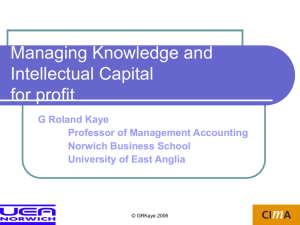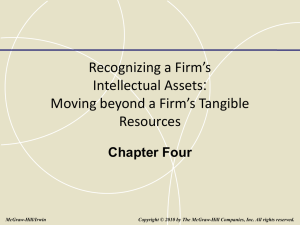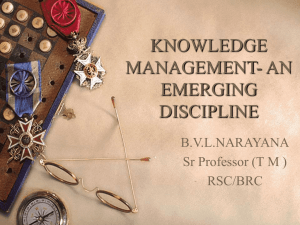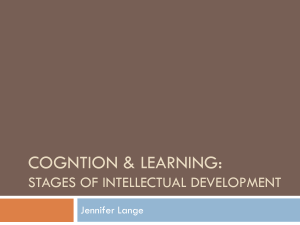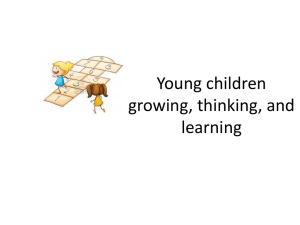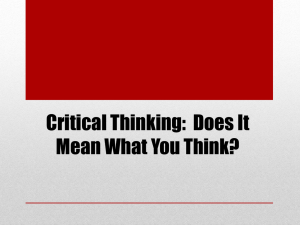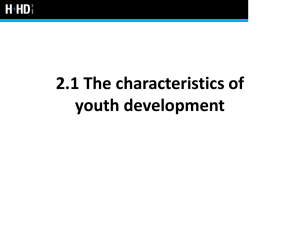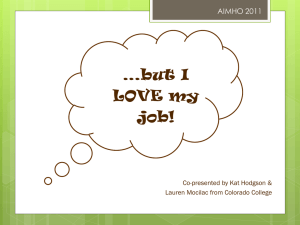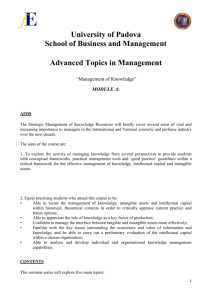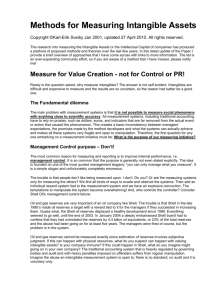INTELLECTUAL CAPITAL
advertisement
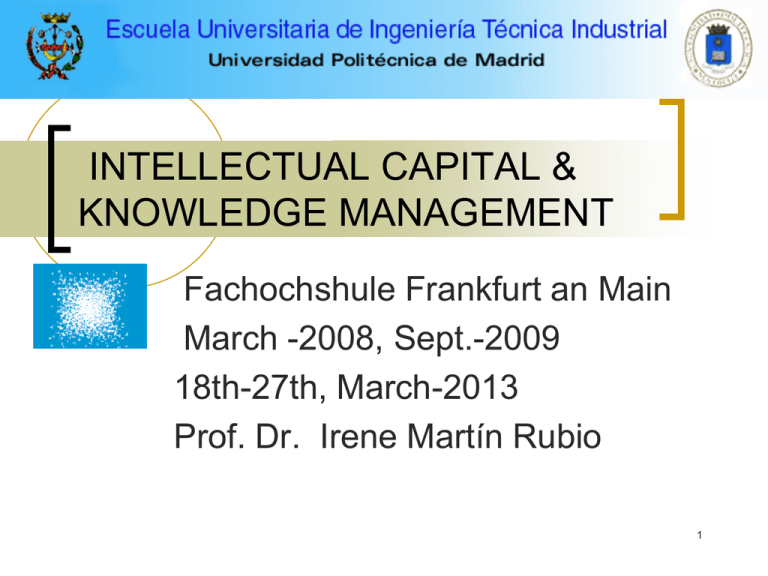
INTELLECTUAL CAPITAL & KNOWLEDGE MANAGEMENT Fachochshule Frankfurt an Main March -2008, Sept.-2009 18th-27th, March-2013 Prof. Dr. Irene Martín Rubio 1 OUTLINE INTELLECTUAL CAPITAL & KNOWLEDGE MANAGEMENT Introduction 1. Knowledge Age & Innovation 1.1. The concept of Organization • Knowledge Management 2. • • • • Data, Information, Knowledge, Competence Spiral of Knowledge Tacit vs. Explicit Knowledge CKO: Chief Knowledge Officer Organizational Learning 3. • • • • Learning Organization vs. Organizational Learning Single Loope Learning vs. Double Loop Learning Activities of Organizational Learning Learn to Learn, Routines, Trust, Team Management Intellectual Capital 4. • • • Valuation of the Firm Components of the Intellectual Capital Report Intellectual Capital Navigator 2 Why are we here? Duplicity – Movie Trailer http://www.youtube.com/watch?v=3KqDuvMANb8 Duplicity- Why are we here? http://www.youtube.com/watch?v=GfoSukpWVos 3 INTRODUCTION Knowledge Age & Innovation The Coming of New Organizations 1.1. The concept of Organization Why study organizations? Effectiveness Organizational Structure and Organizational Design Organizational Design Theory Contemporary Trends 4 21st Century Innovation Management The high demand for new ideas and new product concepts in the knowledge economy posed a major challenge to the organizational innovative ability. 5 New sources of growth: Knowledge-based capital http://www.oecd.org/sti/industryandglobalisation/newsources ofgrowthknowledge-basedcapital.htm http://ec.europa.eu/invest-inresearch/policy/capital_report_en.htm http://www.research-in-germany.de/main/researchlandscape/rpo/networks-and-clusters/41830/10-2-leadingedge-cluster-competition.html 6 KNOWLEDGE AGE “We soon discovered how essential it is for a multibusiness company to become an open, learning organization. The ultimate competitive advantage lies in an organization’s ability to learn and to rapidly transform that learning into action”. Jack Welch – GE (1998) !!!! AGILITY 7 KNOWLEDGE AGE “Information and knowledge are the thermonuclear competitive weapons of our time. Knowledge is more valuable and more powerful than natural resorces, big factories, or fat bankrolls” Thomas A. Stewart –Intellectual Capital 8 KNOWLEDGE AGE – INNOVATION MANAGEMENT LIBERATING INNOVATION FROM BEING THE FUNCTION OF ONE DEPARTMENT (R&D or NPD New Product Develpment) TO AN ACTIVITY TO WHICH EVERYONE CONTRIBUTES. INNOVATION MANAGEMENT PROGRESSED INTO MANAGING AN INNOVATION PORTFOLIO ACROSS A SET OF DISPERSED INTERNAL AND EXTERNAL NETWORKS. 9 KNOWLEDGE AGE – SOCIAL CAPITAL & INNOVATION Innovation Management involves knowing the skills and competencies of employees across the whole organization (HUMAN CAPITAL) and potential partners (SUPLIERS & CUSTOMERS- RELATIONAL CAPITAL) to forge the alliances that facilitate the innovation process. !!! Enabling allocation of human and financial resources to meet stratetic prioriries 10 KNOWLEDGE AGE Success in the Knowledge Age demands that we have the forsight and courage to let go of the Newtonian clockwork or machine metaphor on which most of our organizations are still founded and embrace the logic of self-organization or unmanagement. INDUSTRIAL AGE: Control and dissemination of explicit knowledge –facts,instructions, rules and procedures- by the privileged few. Organizations as machine. Hierarchical and Bureacratic Organizations Machine logic (control and predictability logic KNOWLEDGE AGE: Tacit Knowledge: expertise, reasoning, judgment and insight. Organizations as collective brain power (SOCIAL CAPITAL) Bio-logic 11 KNOWLEDGE AGE ORGANIZATIONS Bio-logic Social organizations are incompatible with formality, distance and contractualism if we want to explore and explote creativity (the human nature). Social organizations proceed smoothly onl with intimacy, subtlety and trust. PEOPLE are not simple a means of production. They are biological systems constantly seeking to fulfill their needs and aspirations. 12 KNOWLEDGE AGE We have entered and era where knowledge is the primary source for wealth creation. We now need to be comfortable with perceptual change, uncertainty, and complexity of our own making. It requires an in-depth understanding of our evolved human qualities and the quest of serendipitous self-organizing systems or bio-logic. 13 The coming of New Organization (P. Drucker) Information & Communication Technology Little Middle Management A good deal of work is done in ad hoc teams as required by every project Flat Structures 14 The coming of New Organization (P. Drucker) Evolutions in the concept and structure of organizations Beguining XX century 1. • • G. Siemens, Germany Differentiation management from ownership 2. 20’s: Modern Corporation Du Pont, General Motors Command-and-control organization Organization of departments and divisions 3. 90’s The organization of knowledge specialists CKO (Chief Knowledge Officer Data, Information, Action, Competitiveness Motivation, Imagination, Creativity : HUMAN NATURE Increasing intellectual capital cannot be managed in the traditional sense, sit all sorts of new-age technologies and associated elaborate metholodgies 15 KM, IC, OL KM OL Organizational Learning Knowledge Management IC 16 Intellectual Capital INTELLECTUAL CAPITAL & KNOWLEDGE MANAGEMENT Introduction 1. • Knowledge Age Knowledge Management 2. • • • • Data, Information, Knowledge, Competence Spiral of Knowledge Tacit vs. Explicit Knowledge CKO: Chief Knowledge Officer Organizational Learning 3. • • • • Learning Organization vs. Organizational Learning Single Loope Learning vs. Double Loop Learning Activities of Organizational Learning Learn to Learn, Routines, Trust, Team Management Intellectual Capital 4. • • • • Valuation of the Firm Components of the Intellectual Capital Report Intellectual Capital Navigator Case Studies 17 Accounting Balance Sheet ASSETS = Equity+Liability Assets Equity Non –current assets Liabilities Non-current Liabilities Current Assets Application of resources INVESTING Current Libilities Source of financial resources FINANCING 18 NON-CURRENT ASSETS TANGIBLE ASSETS Land, building, furniture, equipment… Physical substance. This assets can be bought or manufactured by the company INTANGIBLE ASETS Assets without physical substance RESEARCH & DEVELOPMENT o Research, development, patent GOODWILL 19 GOODWILL It is an intangible asset that compromises the value of all favourable attributes related to a business enterprise such as exceptional management, skilled employees, highly quality products, good and faithful customers… which are very difficult to valuate separetely. It is calculated as the excess of the cost over the fair market value of net assets acquired.In general, goodwill is not amortized because it is considered to have limited life, but it is reviewed for impairment every year. 20 Intangible Assets Intangible Assets Often fuzzy property rights Interactions Teams & equipments& clients Infrequent market transactions Low General Awareness of transaction oportunity High Possible Strategic Value 21 INTELLECTUAL CAPITAL How to manage goodwill? IC-OL-KM How to manage intangible assetss? How to manage innovation? KM: KNOWLEDGE MANAGENT How to measure IC? 22 23


